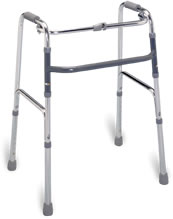
| Walker Facts |
Using a walker safely
How do I use my stable / non-wheeled walker safely?
Do I need a therapist to buy a walker?
 There are four main activities that you need to perform safely when using your walker. These are: standing up, walking, turning, and sitting down. The following are general guidelines and are not appropriate for everybody. You are strongly encouraged to seek guidance from a therapist for your unique situation.
There are four main activities that you need to perform safely when using your walker. These are: standing up, walking, turning, and sitting down. The following are general guidelines and are not appropriate for everybody. You are strongly encouraged to seek guidance from a therapist for your unique situation.
Preparing to Stand Up:
- Move forward and sit as close to the edge of the chair as you feel comfortable.
- Keep your feet as far under you as possible. Aim to place your toes directly below the edge of the chair.
- Place both hands on the arms/seat of your chair OR one hand on the chair and one hand in the centre of the walker frame. Do not tip the walker by placing too much weight on one side of the walker as you stand.
- Lean forward until you feel some of your weight on your feet.
- Use your legs to stand as much as possible – your arms should only lift what your legs cannot. Use your arms mostly to help keep your balance.
- Do not walk forward until you have tested your balance and you feel strong enough to walk.
Preparing to Sit Down:
- Stand directly in front of the chair, facing away from it. The back of your legs should be almost touching the chair.
- Move the walker a little away from you so that you can bend slightly forward as you sit down.
- Reach behind for the chair with both hands (preferred) or with one hand and one hand on the walker.
- Slowly lower yourself using your legs as much as you can.
- If you “plop” into the chair, try leaning a little more forward as you sit and bend your knees to lower yourself closer to the chair before leaning backward.
Walking with a Non-Wheeled Walker:
- Place your walker ahead of you, giving yourself enough room to take steps.
- Do not take any steps while you are holding your walker off the ground. EVER.
- If your steps are uneven, try to shorten your longer step to match your shorter step.
- Move your walker forward after taking one step with each leg.
Turning:
- It should take approximately 2-3 individual steps to turn 180 degrees.
- Place the walker towards the direction you wish to go. Do not take any steps while you are moving the walker.
- Step your feet around until you are facing your walker.
- Repeat the process until you are facing the direction you wish to walk.
- Do not twist through your back when turning as this may cause you to lose balance.
The Sequence of Movements is as Follows:
Pick up and place the walker
Step with one foot
Step with the other foot
Pickup and place the walker again
Common mistakes seen by therapists ...
Choosing the Right Walker
You’ll need to consider much more than physical ability.
What about the environment and social supports?
Do You Need a Therapist?
And if so, how do you find a therapist?
We have a number of associations you may contact.
Where to Purchase a Walker
You have options and we have recommendations.
There is also financial assistance available to you.
Using a Walker Safely
From basic activities to common mistakes, here’s a guide to help you use your non-wheeled walker or wheeled walker safely and effectively.
Frequently Asked Questions
Commonly given answers. Feel free to contact us if you’d like to contribute and help others.
Case Studies
Professionally prepared resources that offer guidance to a successful thought process based on past experiences.
Sponsors
Many thanks to these companies for sponsoring Walker Facts. It's their support that keeps this resource free to everyone.





